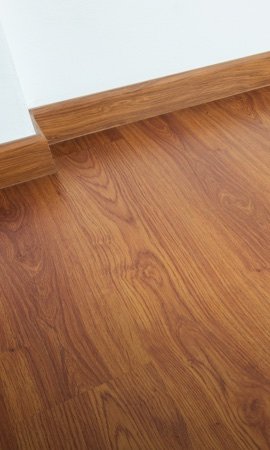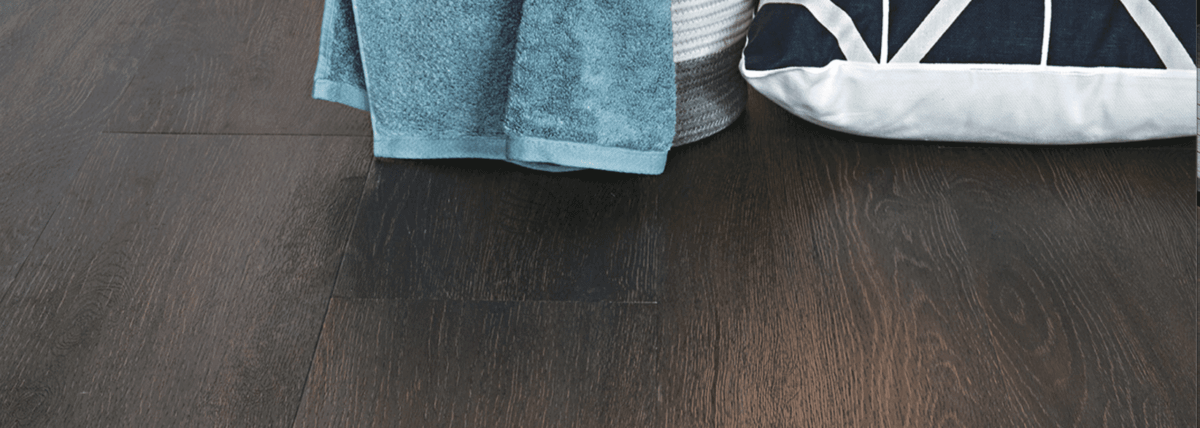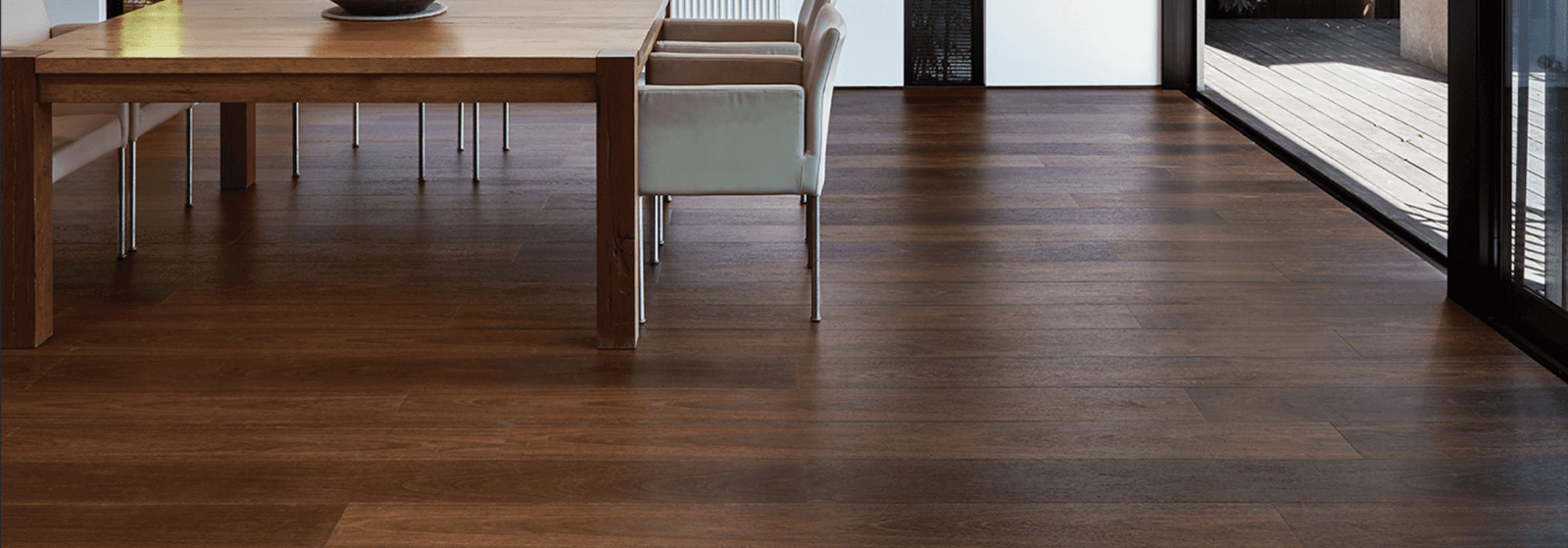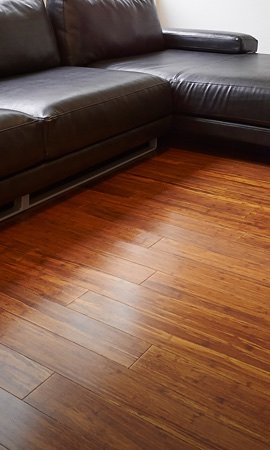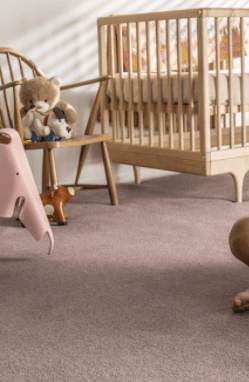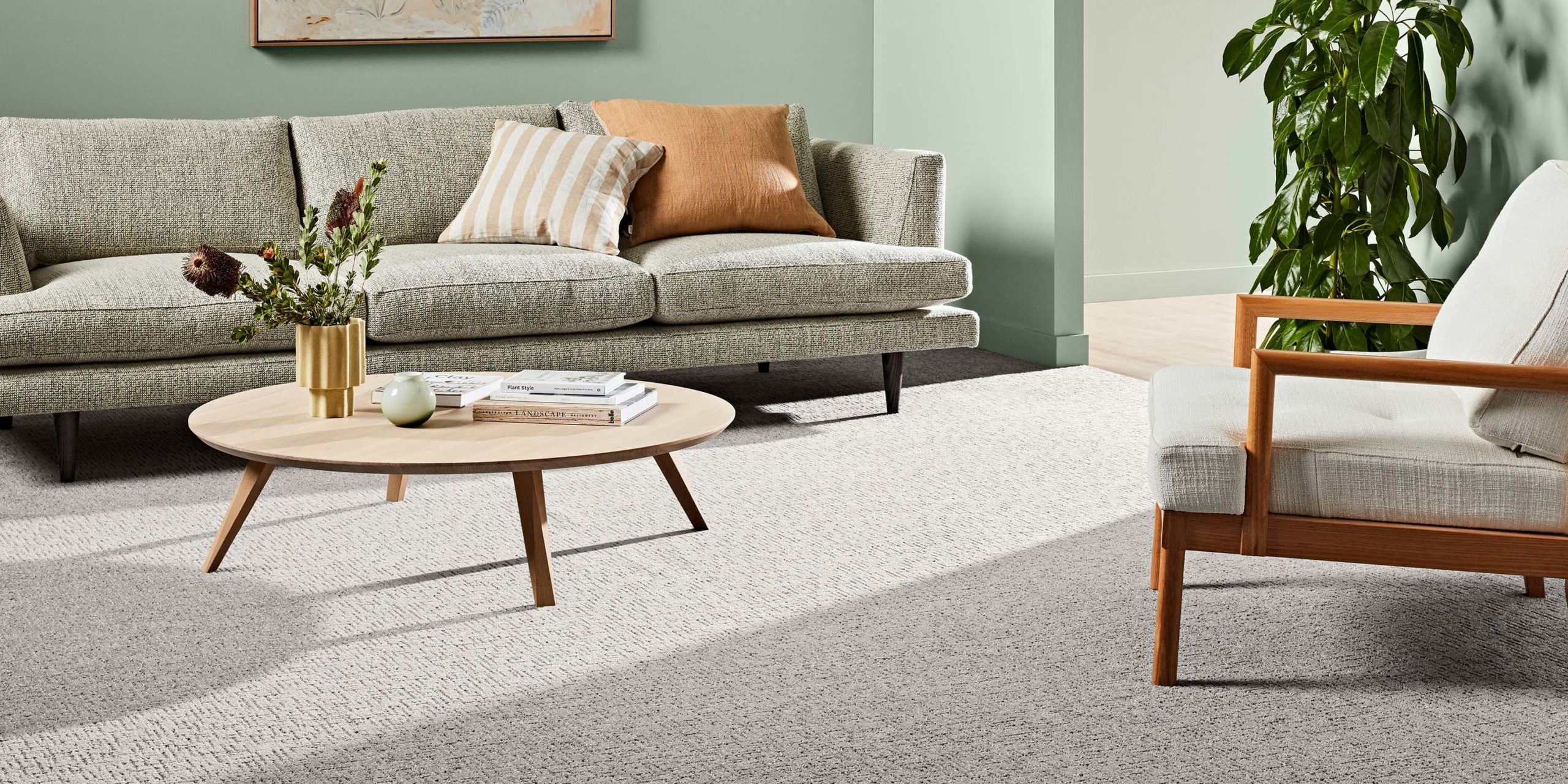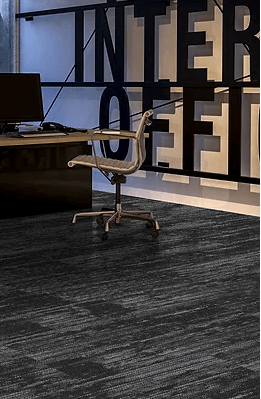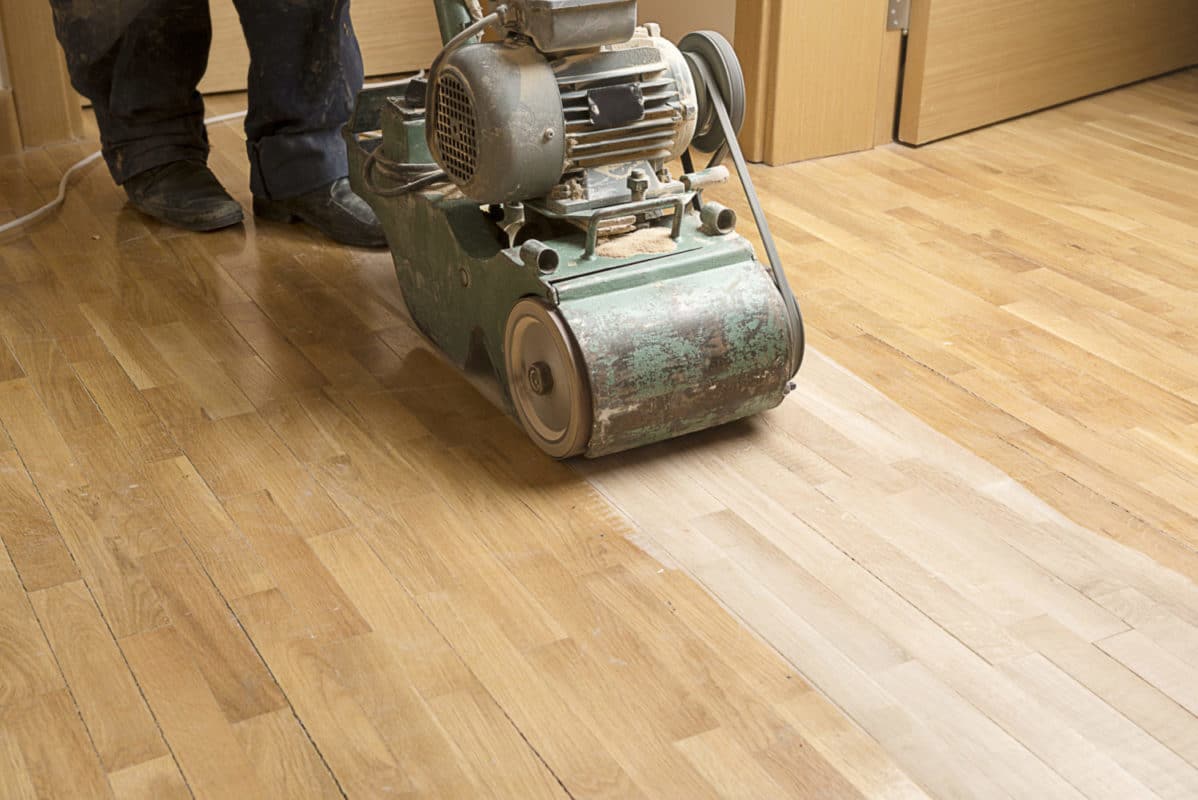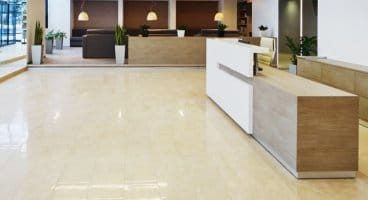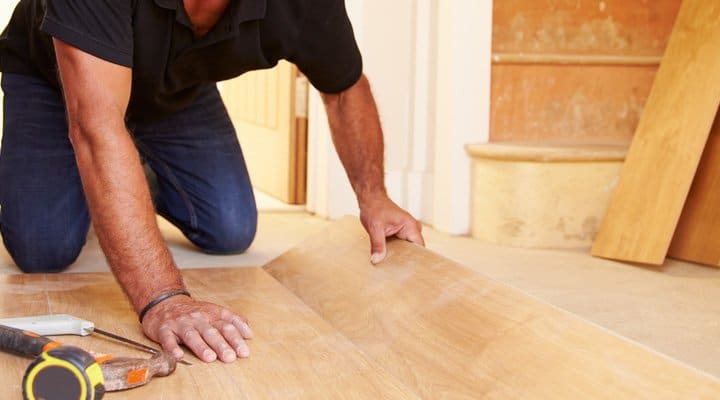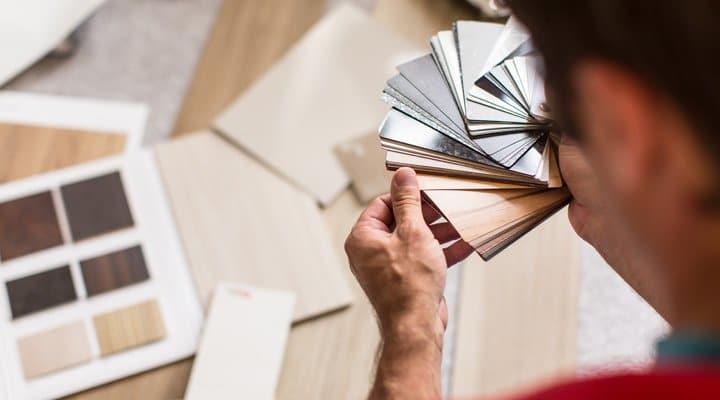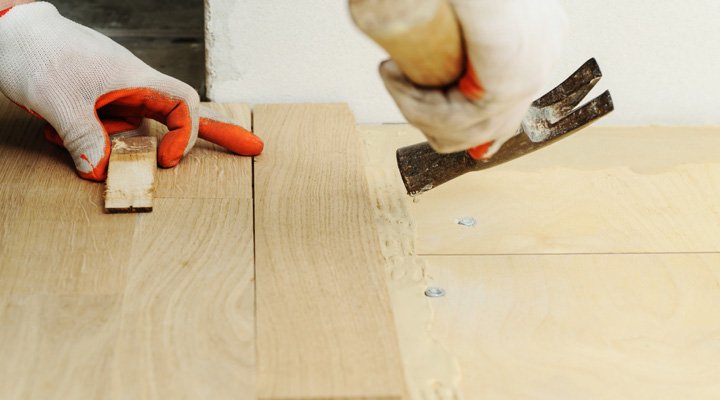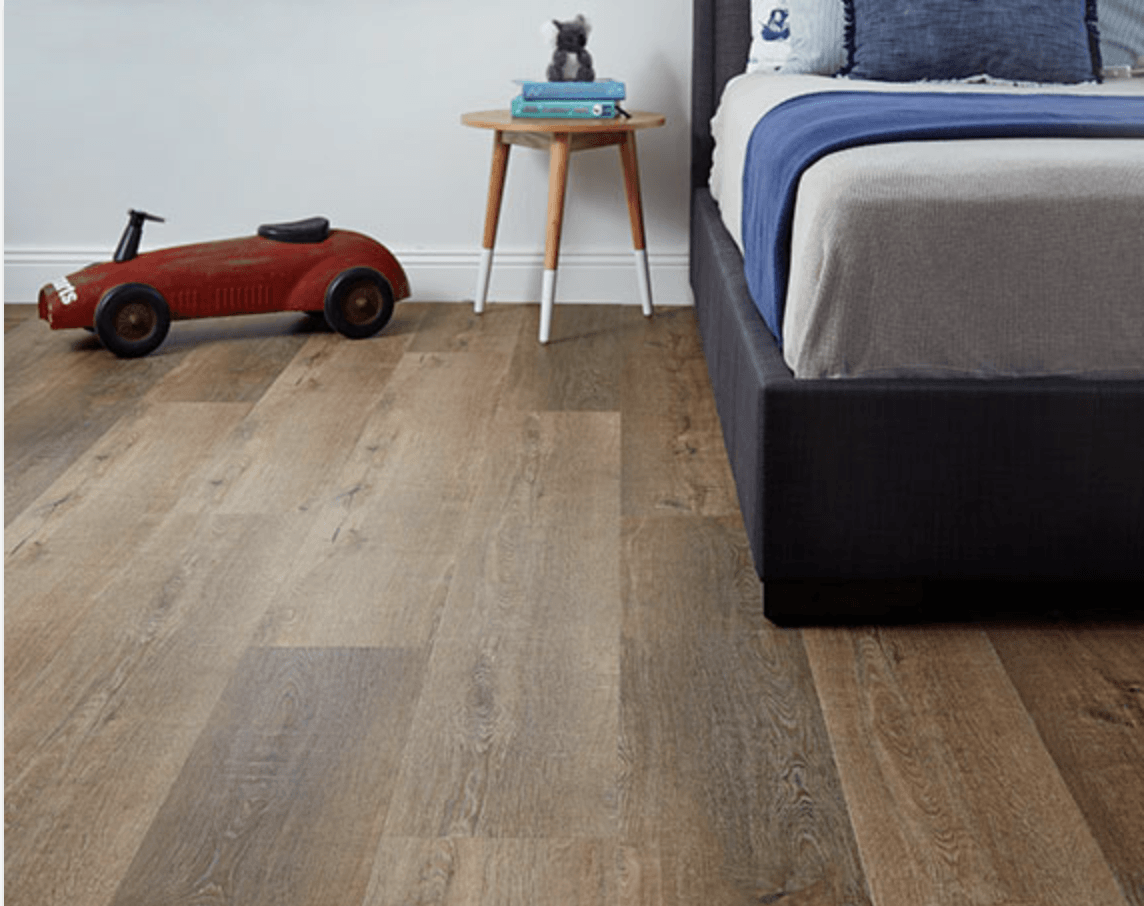

04 Mar The Complete Guide to Choosing a Floor
How to Choose Flooring
You know you need a new floor, but you may not know where to start. There are probably many questions on your mind, such as:
“Which one is the best?”
“Can I afford it?”
These questions probably sound all too familiar. Choosing the best floor for your home can be a confusing process. In fact, there’s no such thing as the “best” floor.
The “best floor” for you is different from the “best floor” for someone else, so you should focus on finding the “best floor for your individual needs”.
Don’t worry, I created this guide to simplify your decision-making process and ensure you know the factors you must be aware of when choosing a floor.
Here are the different types of floorboards to choose from:
- Engineered Floorboards
- Timber Floorboards
- Laminate Floorboards
- Bamboo Floorboards
- Hybrid Floorboards
- Floating Floorboards
I have split this guide into 3 sections. First, I will explain each floor type and its benefits and drawbacks. Secondly. I will cover the 5 most important considerations you should make before committing to a floor. Finally, put together a comprehensive comparison table that compares the different floors across every dimension you need to know.
I’m confident this guide will arm you with everything you need to know to choose the best flooring option for your needs. You’ll probably become a “mini” flooring expert along the way too.
I hope you enjoy this guide and it helps you in choosing the best and most beautiful floor for your home.
Gordon Zhang
Founder & Director, FloorVenue
20+ years of Flooring Experience
Types of Flooring
Firstly, let’s go over the different types of flooring that could be suitable for your home. The term “timber flooring” is a misconception because most people use it to group all types of “wood-like” flooring.
However, most “timber flooring” we refer to is not comprised of real “timber” from trees. Entering the 2020s, the majority of flooring on the market are non-timber and have many additional benefits. In this guide, I will use the term “timber flooring” to only refer to 100% real wood flooring.
In this guide, I will take a very balanced discussion of each type of floorboard, so you can make the best decision. Now, let’s get into the different types of flooring:
Solid Timber (Hardwood) Flooring
Solid timber flooring or “hardwood” flooring has accompanied homes for generations. Believe it or not, solid timber hardwood flooring are one of the only floors made from real “timber” of trees. They have a beautiful natural grain and have the warmth of real timber. As timber floors are made from natural wood, there are limited colours available with solid timber floors compared to other options.
There are two types of hardwood timber floors:
- Raw – minimally processed timber that is first installed into homes, and then later finished (sanded, stained & coated). These are typically considered the most premium and beautiful types of flooring available. Raw timber floors have greater customisation options and a very smooth finish (no grooves between floorboards).
- Pre-finished – are timber floors which are pre-finished in the factory (sanded, stained & coated) and does not require further work at home. They are far more convenient to install than their “raw” alternatives.
PROS
- Authentic and “traditional” real wood
- Lasts a lifetime with proper care & maintenance
- Ages naturally so timbers can become more beautiful over time
- The natural warm feel of real timber and healthier to the human body
CONS
- Most expensive flooring type
- Requires refinishing every few years to get rid of scratches or marks
- Unsuitable for wet areas
- Complicated installation process which involves nailing to underfloor
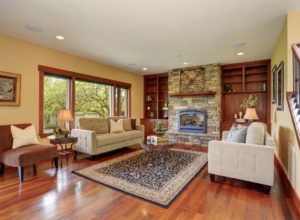

Laminate Flooring
Laminate flooring is a fine-printed photograph laminated onto layers of wood composite material. Laminate floors can mimic the look of real timber flooring, oak timber, bamboo, and just about colour and style an interior designer can create. This is why there are many varieties of laminate floors.
Whilst laminate flooring is not real “wood”, they are becoming increasingly popular because of their superior durability, water/wear resistance, and affordability.
PROS
- Mirrors the natural beauty of timber, oak or other types of flooring
- High durability, withstanding dents & scratches even in high traffic areas
- Very affordable and simpler to install (as a floating floor)
- Little natural variation and maintains colour over time
CONS
- Not real timber and wood
- Not appropriate for highly wet areas such as the bathroom
- May lack some natural feel and touch
- Some poor quality products may be harmful to the human body due to VOC emission
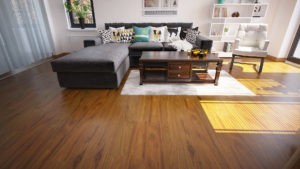

Hybrid Flooring
Hybrid flooring is an innovative new type of flooring, which brings the best characteristics of vinyl and laminate floors together to create an improved floating floor.
Hybrid floors are made of multiple layers of materials pressed together and come in a wide range of designs and styles. The top layer is a UV coated wear & tear layer, the second layer is a decorative print with the desired design, and the centre is a composite core board that is waterproof and stable. Finally, there is an acoustic backing that increases foot comfort and reduces sound resonance.
It is important to understand there are two main types of hybrid floors, differentiated by the composition of their core layer:
- Stone Plastic Composite (SPC) – the core of the floorboards are comprised of stone (natural limestone), polyvinyl chloride and stabilisers. The difference? SPC floors tend to be thinner, denser and slightly more affordable than WPC hybrid floors.
- Wood Plastic Composite (WPC) – the core of the floorboards are comprised of recycled wood and plastic. WPC hybrid floors tend to be thicker, slightly more comfortable underfoot, and slightly pricier than SPC hybrid floors.
PROS
- 100% water-proof compared to other boards
- High durability, withstanding dents & scratches even in high traffic areas
- Maintains colour and quality over time
- Very affordable, easy to install (floating boards) and minimal maintenance required
CONS
- A man-made floor which lacks the authenticity of real timber floors
- May lack the natural feel and touch of timber flooring
- May feel less solid underfoot compared to thicker floorboards


Engineered Flooring
Engineered flooring is a type of layered “timber floor” with an upper layer of hardwood timber with several pieces of plywood. Its the upper layer of hardwood timber is prefinished and bonded to the subsequent plywood layers. They also come in two main styles; Engineered Hardwoods and Engineered Oak.
Engineered floors combine the benefits of real timber floors with the versatility of a floating floorboard design – making it suitable to be installed in apartments.
PROS
- Real timber flooring look and feel
- Greater stability compared to solid timber floors
- Suitable for apartments and unit blocks
- Simpler to install than solid timber floors
CONS
- May be expensive (some engineered floors are almost the price of solid timber floors)
- There is only a thin layer of real timber, making it difficult to sand & polish.
- Timber floors tend to be soft, so the thin upper timber layer may be susceptible to wear and tear.
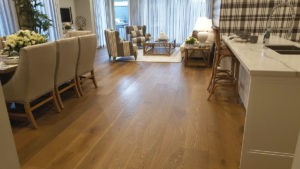

Bamboo Flooring
Bamboo floors are made from a type of grass (bamboo), and yet is harder and more durable than timber floors. Bamboo floors are made through a process shredding of bamboo and pressing it together with glue at high temperatures.
Bamboo has an elegant natural beauty and superior durability, making this style of flooring an increasingly popular choice amongst Sydney homeowners. Bamboo grows in abundance and faster than their tree counterparts, enabling it to be a more affordable and environmentally-friendly alternative to traditional timber floors.
There are three common types of bamboo floor structures:
- Strandwoven Bamboo Flooring – mixes the grass in an interlocked manner, making it the strongest and more expensive choice of bamboo flooring.
- Horizontal Bamboo Flooring – refer to the bamboo being glued together horizontally, resulting in a wider grain pattern.
- Vertical Bamboo Flooring – refer to the bamboo being glued together vertically, leading to a narrower grain pattern.
PROS
- Flooring made from real bamboo
- More affordable than solid timber floors
- Environmentally friendly (bamboo grows faster than trees)
- Suitable for apartments and simpler to install (as a floating floor)
CONS
- Not appropriate for highly wet areas such as the bathroom
- More susceptible to expansion and contraction with temperature variations
- Little variation in colour and style available
- It may contain VOC in manufacturing, it may cause harm to the human body


Key Considerations
Now that you have an understanding of the different types of “timber” or “timber-like” floors, there are a few key considerations you must keep in mind before you make a decision.
Type of Property
Before you begin, there are 3 questions you must ask yourself:
Where are you installing the floor? Is this your own home or commercial property? How long do you intend to live/stay there?
Residential
In general, residential homes have low levels of foot-traffic, no hard-heeled shoes, and your family is likely to be conscious about protecting the floors.
Good news! You have a much wider range of flooring options to choose from, including higher-end solid timber floors all the way to more affordable alternatives like laminate floors.
-
- Personal home – You should choose the floor that makes you feel most comfortable and happy at home, whilst keeping to budget.
- Renting out – Who knows how well your tenants would look after your floors? We generally suggest more durable and affordable man-made floors such as laminate, hybrid or bamboo floors.
- Short vs Long term – If you are not staying long, we recommend being budget-conscious and investing in more economic options such as laminate, hybrid and bamboo floors. If it’s a long-term property, we recommend considering all options including solid timber and engineered floors.
Commercial
You have an office, a showroom or a warehouse. Your new floors must face all sorts of foot-traffic, from heavy boots to metal-heeled high heels.
Your commercial flooring must be durable and reliable. I recommend prioritising functionality, “return on investment”, and accommodate the nature of your business environment. We suggest considering more economical and durable floors like laminate, vinyl and hybrid floors.
How Foot Traffic Affects Your Floor
In summary, foot traffic is a key determinant of which flooring material you should consider. Here’s the general rule:
-
- High Traffic – Synthetic & durable materials like hybrid, vinyl and laminate are able to better handle wear and tear in residential and commercial areas. They also have minimal maintenance requirements.
- Low Traffic – Authentic natural timber, engineered floors (that may be more prone to surface scratching), or synthetic materials (laminate, hybrid, vinyl) can all be great options.
Budget
This is the first question on our minds. Can we afford it?
I understand flooring is a significant investment and making the right decision is critical. However, it can be confusing, for some floorboards are double or even 3 times more expensive than the price of others.
So what exactly contributes to the price differences? Is it the quality of the floor or the installation cost?
I will now provide some transparency around the exact factors which contribute to a new floor.
-
- Material – of the floorboard is the greatest determining factor of price. Real timbers (hardwood, oak, bamboo) are most expensive and man-made floors are the most affordable (laminate, hybrid, vinyl). For timber floors itself, different timbers have different prices.
- Installation Costs – are another major contributing factor to overall costs. As a general guideline, floating floors (click-lock ones that can be installed on an existing subfloor) are simpler and cheaper to install compared to solid timber floors (which require nails and glue). The typical installation costs of floorboards vary between $25 – $80 per square metre.
- Maintenance Costs – different floors have different maintenance requirements. For example, timber floors tend to require sanding and polishing every 10 – 15 years, the cost of that is currently around $30-$40/sqm , whereas laminate and vinyl floors do not require regular resurfacing. If there is a laminate or hybrid floorboard damaged, you do not need to replace the entire floor, you can only replace the particular damaged boards by reversing the installation process. It is much cheaper to repair.
See the table at the bottom of this document for a more in-depth budget comparison by floor-type. If you are in the middle of your buying journey, we have an Ultimate Flooring Cost Guide (published in 2021).


Moisture
Water is hazardous for most floors. Different areas of your house may have varying levels of moisture. Wet areas such as kitchens, basements, and bathrooms should consider only floorboards with some level of water-resistance.
-
- Bathrooms – for highly wet areas such as the bathrooms, only tiles are suitable since they are completely waterproof.
- Kitchens – for partially wet areas such as the kitchen, more options are available, such as hybrid and vinyl. Some higher quality laminate floors also provide a sufficient level of water-resistance and solid/engineered floorings may possibly work. However, we also suggest taking extra care and maintenance with any type of floor in wet areas.
In general, natural floors such as timber or engineered-timber boards are more prone to water damage especially when moisture issues are not addressed quickly. Most laminate floors also have weaker water-resistance.


Installation
Do I install myself or have a professional team to install for me?
It depends on your own ability and the time you have on your hands. In general, floating floors (engineered, laminate, hybrid) are simpler to install than solid timber floors, which need to be glued and nailed to the subfloor.
However, be cautious that DIY installation may invalidate some warranties that come with certain floorboards brands.
-
- Type of Floor – installation prices vary because some floors are easier to install than others. Here is a rough outline of installation costs (last updated in 2021):
- Timber Flooring: $40 – $80 /sqm
- Engineered Flooring: $30 – $40/sqm
- Laminate Flooring: $25 – $30/sqm
- Hybrid Flooring: $25 – $30/sqm
- Vinyl Flooring: $25 – $40/sqm
- Type of Floor – installation prices vary because some floors are easier to install than others. Here is a rough outline of installation costs (last updated in 2021):
Note: These prices may be slightly more competitive than market price. This is the general range of prices we provide at FloorVenue.
-
- Sub Floor Situation – your current sub-floor (where you will lay the flooring) situation determines the ease of installation. Some common conditions that increase complexity include:
- Uneven subfloors – requiring installers to level the subfloor before installation.
- Underfloor moisture – requiring subfloor waterproofing and/or extra moisture barrier before installation.
- Area of House – stairs, doors, and wardrobes require more time spent on installation. For example, curved staircases will take time to reshape the floor to the specific curve of the floor, and floorboards need to be cut and matched to specific wardrobes. These more complex areas of the house require greater skill and time, increasing the installation costs.
- Sub Floor Situation – your current sub-floor (where you will lay the flooring) situation determines the ease of installation. Some common conditions that increase complexity include:
Considering a DIY installation? Lucky for you, we have a step by step Guide to Installing Floating Flooring!
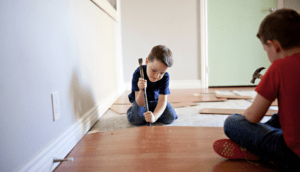

Maintenance
In general, all flooring requires much less maintenance than carpets. However, there are still slight variances between different types of floors so it is worthwhile to consider the time and energy you have to maintain the floors.
-
- Slightly higher maintenance – the authenticity and beauty of timber and engineered floors may come at the cost of additional care and seasonal maintenance. Solid timber or engineered boards may require greater care since their surfaces are more prone to scratching and denting. Re-sanding and polishing may maintain the pristine beauty of these natural surfaces.
- Slightly lower maintenance – synthetic floors such as laminate, hybrid, and vinyl floors tend to require lower levels of maintenance due to their durability.
Flooring Comparison Table
If you’ve read up to here, I know you’ve had a lot to absorb. To summarise everything above, I’ve created a comparison table for you:
| Type of Floor | Durability | Water Resistance | Apartment Suitability | Installation | Market Price (inc installation) |
| Solid Timber | Medium-
High |
Low – Medium | Sometimes | Complex | Expensive
($120 – $180 /sqm) |
| Hybrid & Vinyl | High | High | Yes | Simple | Affordable
($55 – $70 /sqm) |
| Laminate | High | Low – Medium | Yes | Simple | Affordable
($40-$75 /sqm) |
| Engineered Timber | Medium | Low – Medium | Yes | Simple | Moderate
($100-$150 /sqm) |
| Bamboo | High | Low- Medium | Yes | Simple | Affordable
($65-$85 /sqm) |
| Tiles | High | High | Sometimes | Complex | Moderate
$80-$140 (/sqm) |
Note: This is just a general guide because there may be variations with each type of floor.
So What Do I Choose?
It really depends on you. There is no right or wrong choice, but rather what fits your individual requirements.
Ask yourself the key considerations I’ve mentioned above and evaluate each floor against your needs. If you have any questions or need any further advice, please feel free to reach out to me here or on 9831 7621.
About FloorVenue
FloorVenue is NSW’s leading supplier and installer of quality and beautiful flooring solutions. We have helped thousands of families and numerous home-builders, construction companies and businesses with new flooring.
We started from humble beginnings, where my garage was used as the first warehouse. We started as a wholesaler and eventually expanded into retail and installation services. Our wholesale origins continue to enable us to provide the lowest prices on premium floors to our customers.
Our mission is to always provide the greatest value and care to our customers. We hope we have the opportunity to support your flooring selection journey.
Gordon Zhang
Founder & Director, FloorVenue

